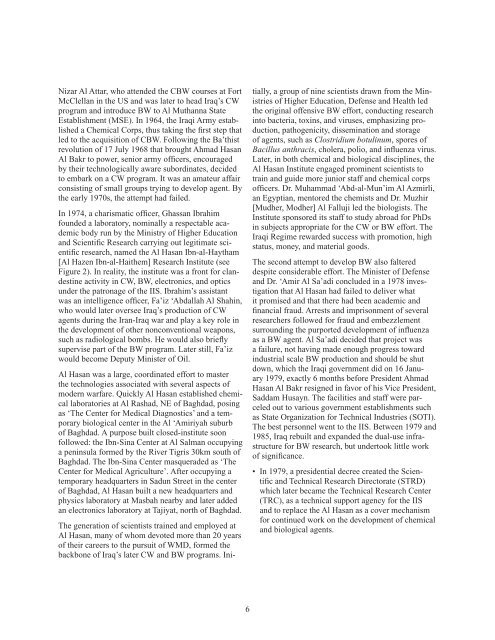Comprehensive Report
GPO-DUELFERREPORT-3
GPO-DUELFERREPORT-3
- No tags were found...
Create successful ePaper yourself
Turn your PDF publications into a flip-book with our unique Google optimized e-Paper software.
Nizar Al Attar, who attended the CBW courses at Fort<br />
McClellan in the US and was later to head Iraq’s CW<br />
program and introduce BW to Al Muthanna State<br />
Establishment (MSE). In 1964, the Iraqi Army established<br />
a Chemical Corps, thus taking the first step that<br />
led to the acquisition of CBW. Following the Ba’thist<br />
revolution of 17 July 1968 that brought Ahmad Hasan<br />
Al Bakr to power, senior army officers, encouraged<br />
by their technologically aware subordinates, decided<br />
to embark on a CW program. It was an amateur affair<br />
consisting of small groups trying to develop agent. By<br />
the early 1970s, the attempt had failed.<br />
In 1974, a charismatic officer, Ghassan Ibrahim<br />
founded a laboratory, nominally a respectable academic<br />
body run by the Ministry of Higher Education<br />
and Scientific Research carrying out legitimate scientific<br />
research, named the Al Hasan Ibn-al-Haytham<br />
[Al Hazen Ibn-al-Haithem] Research Institute (see<br />
Figure 2). In reality, the institute was a front for clandestine<br />
activity in CW, BW, electronics, and optics<br />
under the patronage of the IIS. Ibrahim’s assistant<br />
was an intelligence officer, Fa’iz ‘Abdallah Al Shahin,<br />
who would later oversee Iraq’s production of CW<br />
agents during the Iran-Iraq war and play a key role in<br />
the development of other nonconventional weapons,<br />
such as radiological bombs. He would also briefly<br />
supervise part of the BW program. Later still, Fa’iz<br />
would become Deputy Minister of Oil.<br />
Al Hasan was a large, coordinated effort to master<br />
the technologies associated with several aspects of<br />
modern warfare. Quickly Al Hasan established chemical<br />
laboratories at Al Rashad, NE of Baghdad, posing<br />
as ‘The Center for Medical Diagnostics’ and a temporary<br />
biological center in the Al ‘Amiriyah suburb<br />
of Baghdad. A purpose built closed-institute soon<br />
followed: the Ibn-Sina Center at Al Salman occupying<br />
a peninsula formed by the River Tigris 30km south of<br />
Baghdad. The Ibn-Sina Center masqueraded as ‘The<br />
Center for Medical Agriculture’. After occupying a<br />
temporary headquarters in Sadun Street in the center<br />
of Baghdad, Al Hasan built a new headquarters and<br />
physics laboratory at Masbah nearby and later added<br />
an electronics laboratory at Tajiyat, north of Baghdad.<br />
The generation of scientists trained and employed at<br />
Al Hasan, many of whom devoted more than 20 years<br />
of their careers to the pursuit of WMD, formed the<br />
backbone of Iraq’s later CW and BW programs. Initially,<br />
a group of nine scientists drawn from the Ministries<br />
of Higher Education, Defense and Health led<br />
the original offensive BW effort, conducting research<br />
into bacteria, toxins, and viruses, emphasizing production,<br />
pathogenicity, dissemination and storage<br />
of agents, such as Clostridium botulinum, spores of<br />
Bacillus anthracis, cholera, polio, and influenza virus.<br />
Later, in both chemical and biological disciplines, the<br />
Al Hasan Institute engaged prominent scientists to<br />
train and guide more junior staff and chemical corps<br />
officers. Dr. Muhammad ‘Abd-al-Mun’im Al Azmirli,<br />
an Egyptian, mentored the chemists and Dr. Muzhir<br />
[Mudher, Modher] Al Falluji led the biologists. The<br />
Institute sponsored its staff to study abroad for PhDs<br />
in subjects appropriate for the CW or BW effort. The<br />
Iraqi Regime rewarded success with promotion, high<br />
status, money, and material goods.<br />
The second attempt to develop BW also faltered<br />
despite considerable effort. The Minister of Defense<br />
and Dr. ‘Amir Al Sa’adi concluded in a 1978 investigation<br />
that Al Hasan had failed to deliver what<br />
it promised and that there had been academic and<br />
financial fraud. Arrests and imprisonment of several<br />
researchers followed for fraud and embezzlement<br />
surrounding the purported development of influenza<br />
as a BW agent. Al Sa’adi decided that project was<br />
a failure, not having made enough progress toward<br />
industrial scale BW production and should be shut<br />
down, which the Iraqi government did on 16 January<br />
1979, exactly 6 months before President Ahmad<br />
Hasan Al Bakr resigned in favor of his Vice President,<br />
Saddam Husayn. The facilities and staff were parceled<br />
out to various government establishments such<br />
as State Organization for Technical Industries (SOTI).<br />
The best personnel went to the IIS. Between 1979 and<br />
1985, Iraq rebuilt and expanded the dual-use infrastructure<br />
for BW research, but undertook little work<br />
of significance.<br />
• In 1979, a presidential decree created the Scientific<br />
and Technical Research Directorate (STRD)<br />
which later became the Technical Research Center<br />
(TRC), as a technical support agency for the IIS<br />
and to replace the Al Hasan as a cover mechanism<br />
for continued work on the development of chemical<br />
and biological agents.<br />
6


